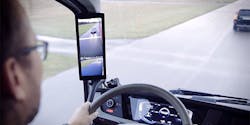The Federal Motor Carrier Safety Administration (FMCSA) has granted Stoneridge Inc. a five-year exemption to install its camera-monitoring system on trucks instead of traditional rear-view mirrors.
The company said “MirrorEye” uses integrated external digital cameras and digital monitors inside the cab. That provides an expanded field of view, full-color night vision, and the ability to continuously track the end of the trailer.
In a Federal Register posting, FMCSA said the “use of the MirrorEye system in lieu of mirrors would likely achieve a level of safety equivalent to or greater than the level of safety provided by the regulation.”
The notice also stated that Stoneridge believes the system could reduce driver fatigue “by requiring less head movement by drivers compared to the number of head movementneeded to use conventional mirrors.”
While the system is currently an aftermarket product, FMCSA’s decision could pave the way for MirrorEye and other camera systems to one day be built into new trucks.
Other companies including Daimler Trucks North America have requested exemptions to use cameras instead of mirrors. Besides safety benefits, these companies have also cited higher fuel efficiency through improved aerodynamics.
In comments to FMCSA, truckload carriers Schneider and J.B. Hunt Transport Services said they have been using the system along with required mirrors.
Schneider said its truck drivers have "had an overwhelmingly positive experience" with the system, while J.B. Hunt wrote "we have not been involved in any collisions and have received overwhelming positive feedback from our test drivers."
However, the Commercial Vehicle Safety Alliance questioned whether the “technology has a proven safety benefit.” It also expressed concern whether the camera system could “undermine consistency and uniformity in compliance enforcement.”
About the Author
Neil Abt
Neil Abt is a former FleetOwner editor who wrote for the publication from 2017 to 2020. He was editorial director from 2018 to 2020.
